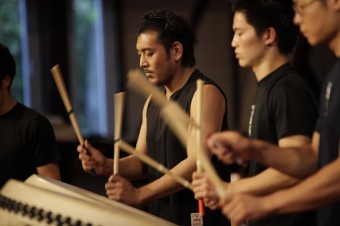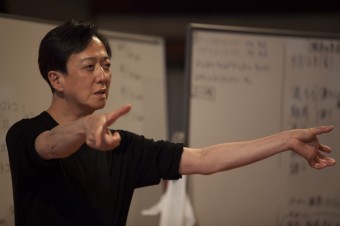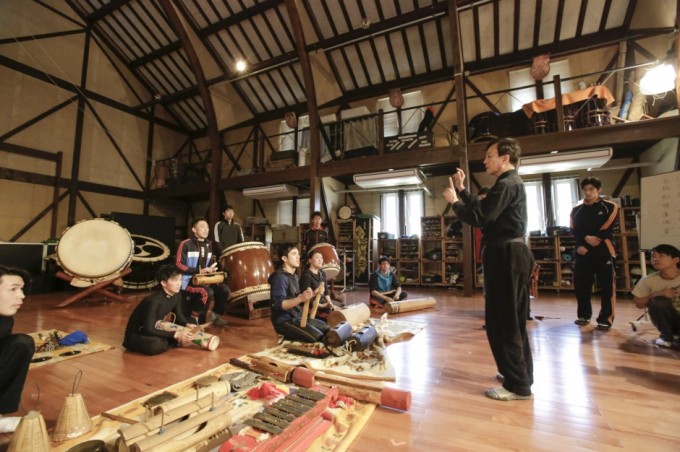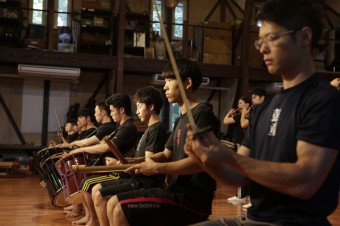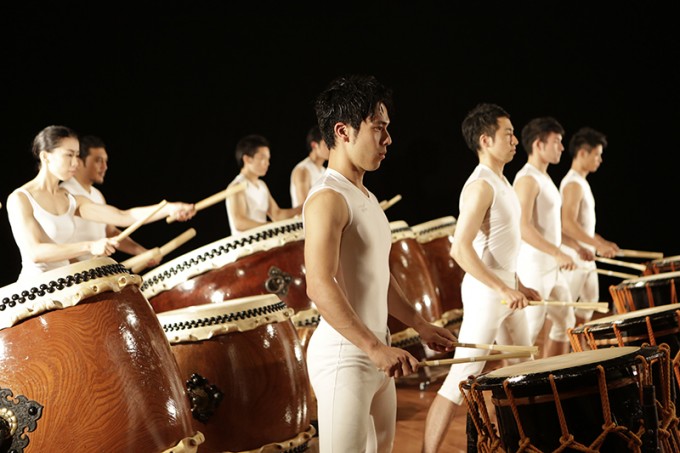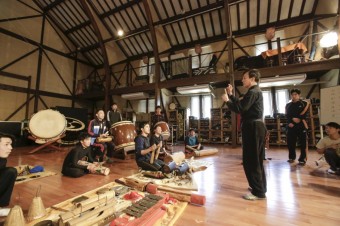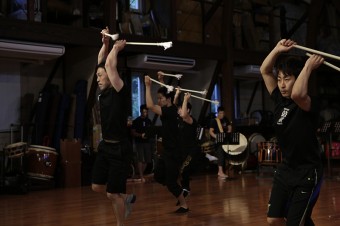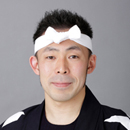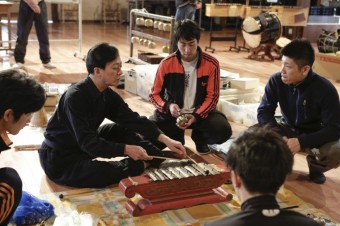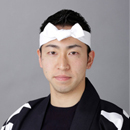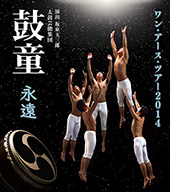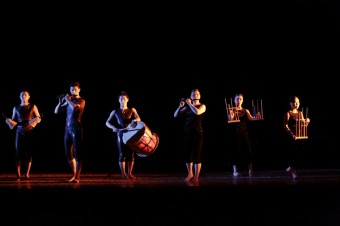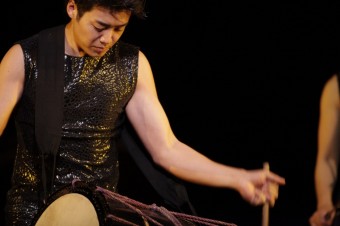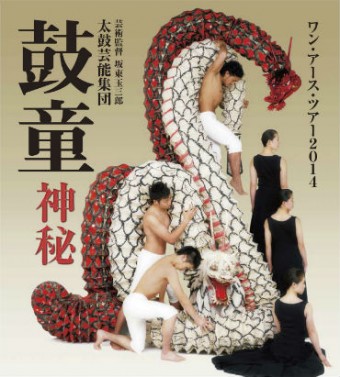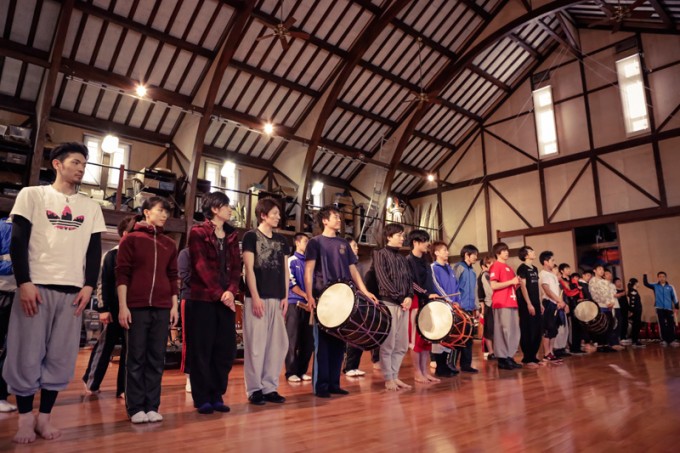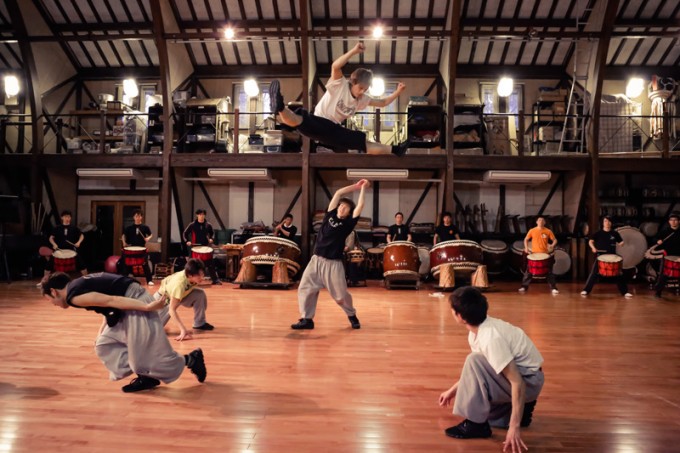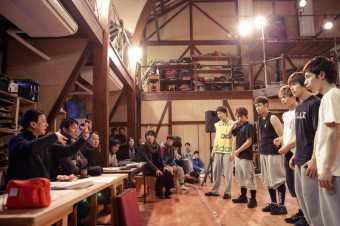Production Info
Kodo Rehearsal Report: “Eternity,” the Origin of Kodo and Taiko –Part 4–
“Eternity,” the Origin of Kodo and Taiko –Part 4–
Original Japanese Article by Koichi Imai (Freelance Writer) ● Photos by Takashi Okamoto
Accumulated Knowledge and Experience: Harnessing Knowledge Towards New Discoveries, Kodo Style

Kodo members not only harness the power and allure of the taiko, they find something new that transcends the taiko itself, and it is this indescribable experience that they share with the audience. That is a depiction of “eternity.” Once again, they revert to their purest selves as they face the taiko. After taking the time to analyze the taiko in all of its sounds and possibilities, they discard everything they know and start all over again in search of something new. In “Eternity,” the O-daiko (big drum), which used to be a requisite symbol of Kodo that typically marked the climax, never even appears on stage. But I do not find this the least bit strange. In its stead, various taiko conjure a wealth of other expressions, some of which do not sound like taiko at all. That is what makes a strong, tenacious taiko performance stand out and lets the performers move us. At the same time, I feel the amazing power of Kodo’s accumulated history, methodologies, experiences, and environment spanning over thirty years. One of the group’s challenges is also to find new meaning in these things.
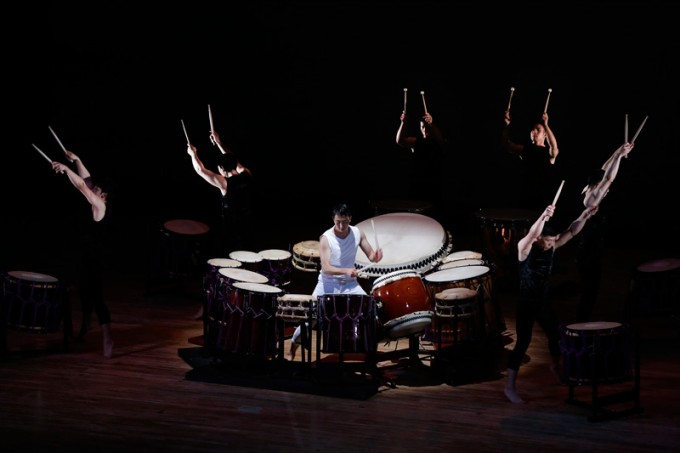
“We have been trying all manner of things since Tamasaburo (Bando) became our artistic director, no matter what people said,” explains Masayuki Sakamoto. “I hope that people come to consider what we do as a whole as a ‘Kodo performance,’ not to label it as new or old. I hope that we can find our voice equally in traditional pieces as well as fields such as contemporary dance.”
Kodo Rehearsal Report: “Eternity,” the Origin of Kodo and Taiko –Part 3–
“Eternity,” the Origin of Kodo and Taiko –Part 3–
Original Japanese Article by Koichi Imai (Freelance Writer) ● Photos by Takashi Okamoto
“What is Wadaiko?”: This Simple Question Opens Doors to New Possibilities
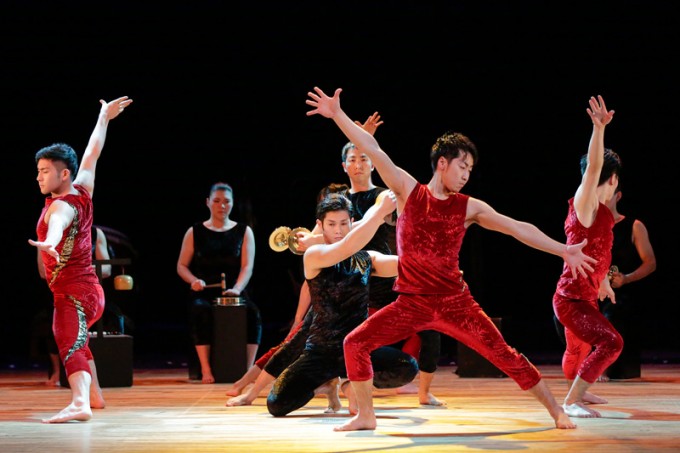
The second half of “Eternity” also started with the orin gong. This perhaps acts as a charm to transport the audience into another world. An ensemble of chappa (small cymbals) and bells are played at the opening. Four performers slip out of the ensemble to begin dancing in an arrangement that feels at once ancient and contemporary. They invite the audience to enter another dimension along with the mysterious melody of the chappa and gamelan (Indonesian percussive instruments).
Transported to another dimension, you encounter Takibi (composed by Yosuke Oda). It is a very unique piece, which will shatter your established ideas about taiko. Five performers trace the rims of the taiko with their drumsticks as they draw circles, tapping them as they go around. It is in using every element of the taiko like this that they are able to create sounds and rhythms beyond traditional taiko. At risk of being misunderstood, I would almost say I feel like I am at a “Stomp” performance, in which the players use brooms and metal drums as musical instruments. I can’t believe that I am listening to the taiko. It is well known that Stomp was heavily influenced by Kodo, and it is in this moment I understand that Kodo represents one of the top percussion performances in the world and the taiko has tremendous possibilities.
“When I thought of ‘eternity,’ I felt the need to travel backward in time,” explains Yosuke Oda. “Eternity spans not only into the future, but also the past. So I tried to imagine taiko before its present playing style was established and decided not to use common taiko rhythms. Some people today may say that what we are playing is not ‘taiko,’ but no one knows how the instrument was actually played in ancient times. The idea of ‘common’ taiko playing was made after a basic taiko style had been constructed.”
Oda arrived at this idea through his experiences in “Legend” and “Mystery,” once he had grasped what the Artistic Director, Tamasaburo Bando, was hoping to achieve. Tamasaburo’s ideas could be similar to those that he applies in Kabuki, not only as a traditional performance, but also as a modern form of expression. When Oda, who is a core figure in the Kodo ensemble, comes up with such a liberated idea, it is bound to have great influence on other members.
Kodo Rehearsal Report: “Eternity,” the Origin of Kodo and Taiko –Part 2–
“Eternity,” the Origin of Kodo and Taiko –Part 2–
Original Japanese Article by Koichi Imai (Freelance Writer) ● Photos by Takashi Okamoto
Orders from the Artistic Director Help Us Rediscover the Allure of Taiko
This particular run-through rehearsal was held in the middle of September 2014. The atmosphere was slowly changing from the summer air of Kodo’s outdoor festival “Earth Celebration,” held between August 21 and 23, into an autumnal mood. But despite the cool winds blowing outside, the rehearsal hall at Kodo Village was warmed by the energetic rehearsals for “Kodo One Earth Tour: Eternity.” As the Kodo performers had been scattered all over the world on separate tours in the months prior, rehearsals in which all members were present were extremely rare and the level of concentration was intense. “Let’s use all new pieces for this programme,” said Artistic Director Tamasaburo Bando, and that’s how everything for “Eternity” started in January 2014. Until then, Kodo had mostly assembled or arranged their tried-and-tested pieces to form a programme, but “Eternity” was not created in this way: Instead, it began from scratch.
The Kodo members were invited to share their visions of “Eternity,” and discuss these as a group. “We shared ideas and talked together a couple of times,” explains performer Yuichiro Funabashi. “Some of the ideas were in the form of music, others members had ideas about how the taiko should be played or the positioning of the instruments; it could have been anything. Then Tamasaburo took these ideas and began to build the programme. He arranged some ideas into new pieces, used parts from others, and thus the programme developed.” Afterward, the “seeds” the Artistic Director planted had to be nurtured by the Kodo members, and the overall vision for the programme became clear at the beginning of September.
Kodo Rehearsal Report: “Eternity,” the Origin of Kodo and Taiko –Part 1–
“Eternity,” the Origin of Kodo and Taiko –Part 1–
Original Japanese Article by Koichi Imai (Freelance Writer) ● Photos by Takashi Okamoto
When I first visited Sado Island, I was impressed by the powerful sun setting beyond the horizon. This autumn, a new Sado Kisen Car Ferry had just been christened the Akane, which means “powerful red,” an image that perfectly captured the essence of that sunset. The name also calls to mind the toki (Japanese crested ibis), a protected species of bird raised with deep care and affection on the Island. I remember thinking that the sunset on Sado captured all of the island’s brilliant natural splendor at once; somehow it was much more dramatic on that day than any other.
While I was watching the rehearsal of Kodo’s new programme “Kodo One Earth Tour: Eternity,” this same feeling came to mind. The rehearsal had a nostalgic feel, like an autumn festival from days past. The warm sounds of the drum and the warmth of the sun setting behind the stage seemed to capture the essence of Sado completely.
By any measure, “Eternity” is a profound and epic title.
Artistic Director Tamasaburo Bando explains this choice as follows:
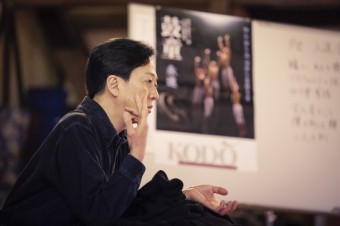
“When I was contemplating the theme of eternity, it occurred to me that ‘the workings of nature’ unfold in cyclical patterns, and that perhaps in identifying those patterns, we could express ‘eternity.’ Strictly speaking, there is probably no such thing as ‘eternity,’ for us mortals, but there are some things that are eternal. The dawn, light, rain, wind, clouds, waves, stars, dusk, the night sky; and amongst all these, I saw ‘human beings.’”
The Rehearsal Hall: A Forum for Trial and Error Filled with Heart, Sounds, and Smiles
The workings of nature have enormous power that cannot be fathomed nor controlled by human intellect. A mysterious life force resides in even the tiniest buds. Perhaps eternity can be found in the different sounds of the taiko used to express the workings of life itself.
The opening piece, Yogiri (composed by Tsuyoshi Maeda), introduces the drama about to unfold as it spreads out into the darkness like a giant projection screen. The high-pitched tone of the orin (Buddhist altar bell) echoes like a cool wind blowing across the Island. Shinobue (bamboo flute) melodies call to mind the musical accompaniments of the autumn festival mentioned above, as various percussion instruments beat the base rhythm. This combination conjures an air of nostalgia for a time gone by, when repeated patterns somehow wove the fabric of our daily lives. At the same time, the sounds of waves and wind intertwine. The lasting effect of this piece is an appreciation of the richness of the nature– the ocean, mountains, et al– on Sado Island.
“Kodo One Earth Tour: Eternity” Cast Interviews
“Kodo One Earth Tour: Eternity”
We are proud to present the third work directed by artistic director Tamasaburo Bando: an evolutionary performance entitled “Eternity.” This production will premiere on Sado Island in November and tour around the major cities in Japan from late November through December. During their intense rehearsals, we interviewed two of the cast members: Mitsuru Ishizuka and Tsuyoshi Maeda.
Interviewees: Mitsuru Ishizuka, Tsuyoshi Maeda
Photos: Takashi Okamoto
From Monthly Japanese Newsletter “Kodo” Vol. 337 issued in July, 2014
When I was mulling over the theme of eternity, it occurred to me that “the workings of nature” unfold in spiral patterns. By enumerating “the workings of nature,” maybe we could express “eternity.” Strictly speaking there probably is no such thing as “eternity,” but as things that are connected to it, there’s dawn, light, rain, wind, clouds, waves, stars, dusk, the night sky, and amongst all these, I saw “human beings.”
Tamasaburo Bando
Mitsuru Ishizuka
The Beginnings of the Third Work by our Artistic Director
The creation of this production started without any plan or scenario: it began with the words, “So, what shall we do?” So, it felt new, scary, and exhilarating. We have been working with Tamasaburo Bando for more than ten years, it has been three years since he became our artistic director, and at last we reached a point where we could create a programme with him from scratch. I think Kodo has entered into new territory and this production will be an unprecedented taiko concert.
A Multitude of Musical Instruments
Kodo is primarily a group that gives concerts that let audiences listen to taiko. But I think the productions directed by Tamasaburo, first “Legend” and then “Mystery,” used taiko and performing arts as a base and then added more visual elements to create concerts for audiences to watch.
I feel that his third programme, “Eternity,” simply depicts human beings, rather than being a “concert” or a “show.” Because of that, there are less pieces where we play taiko with all our might, and more pieces with all kinds of small instruments, which we use express our various emotions. With a multitude of instruments, we portray a range of scenes such as having a conversation, taking a nap, and falling rain.
When I first heard the name “Eternity,” I thought the scale of the theme was so big. But now, in a sense, I think this is going to be our most human, life-sized performance to date.
Tsuyoshi Maeda
New Eternity-Themed Pieces
For me, the first thing that sprung to mind as a motif was “nature.” The concept of eternity is hard for me to grasp, but it made me things that create a span like the workings of nature. It also made me think of “time.” Music that loops and creates a trance also creates that sort of span, so this production features new pieces with those kinds of repetitive rhythms. I composed a piece for Eternity called Yogiri (Night Fog), which is played by intently beating the taiko and playing bonang (Indonesian percussion instruments) and rin gongs (Buddhist bells). I created it with the hope that even when this piece ends, it feels like it carries on; even when the sound ends, the musical realm lingers eternally.
Many of the other pieces composed by Kodo members for this programme were also melody-based. I guess that is because we all were trying to express nature and scenery. Perhaps “eternity” makes us all imagine something enormous that cannot be expressed just by looping rhythms. For me, the word “eternity” conjures such a massive image, so it’s hard to comprehend it and connect it to more concrete ideas. It is really difficult to find answers when I start pondering the question, “What is eternity?”
Nov. 20 (Thu) Amusement Sado, Sado Is., Niigata
Nov. 30 (Sun) City Hall Plaza “Aore Nagaoka,” Nagaoka, Niigata
–”Heartbeat Project” Special Version–
Dec. 2 (Tue) Muza Kawasaki Symphony Hall, Kawasaki, Kanagawa
Dec. 4 (Thu) Aichi Prefectural Arts Theater Concert Hall, Nagoya, Aichi
Dec. 6 (Sat) & 7 (Sun) NHK Osaka Hall, Osaka City
Dec. 10 (Wed) Okayama Civic Hall, Okayama City
Dec. 12 (Fri) Ueno Gakuen Hall, Hiroshima City
Dec. 15 (Mon) & 16 (Tue) Hakataza Theater, Fukuoka City
Dec. 19 (Fri)–23 (Tue/Public Hol.) Bunkyo Civic Hall, Bunkyo Ward, Tokyo
Dec. 25 (Thu) Niigata Prefectural Civic Center, Niigata City
“Kodo One Earth Tour: Mystery” Message from Yuta Sumiyoshi (Japanese)
The fall “Kodo One Earth Tour 2014: Mystery” Japan Tour begins this month. In this video, cast member Yuta Sumiyoshi talks about “Mystery.” (Note: This message is in Japanese)
Watch on You Tube▶http://youtu.be/Cv1EkQP4Zpo
Photos: Takashi Okamoto
EC 2014 Shiroyama Concert Rehearsals
Earth Celebration 2014 Shiroyama Concert Rehearsals
These photos show scenes from the EC 2014 rehearsals at Kodo Village, held April 11-13.
Photos by Takashi Okamoto




